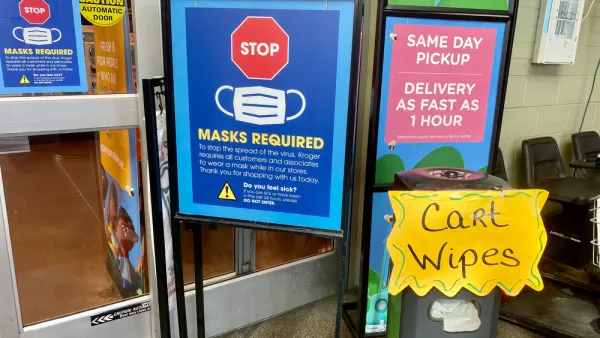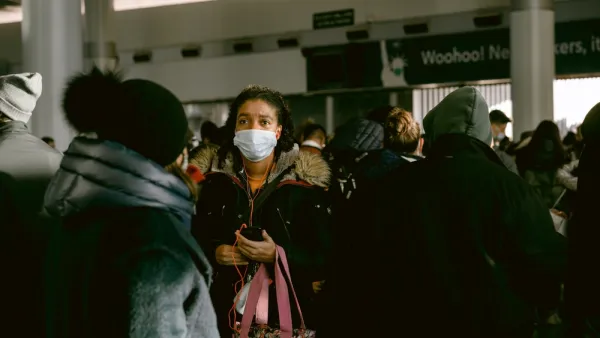The pandemic will end and SARS-CoV-2 may evolve to become a mild, endemic cold coronavirus, warns Aris Katzourakis, a professor of viral evolution and genomics in an opinion for Nature. Examples of other endemic diseases are malaria and tuberculosis.

"As cases decline in some parts of the country, many have begun to hope that this surge is the last big battle with the virus — that because of its unique characteristics, the Omicron variant will usher Americans out of the pandemic," writes global health reporter Apoorva Mandavilli for The New York Times on January 27.
She warns that "it is not likely that the coronavirus will ever completely disappear, many scientists said, and herd immunity is now just a dream. The population’s immunity against the virus will be imperfect, for a variety of reasons."
Instead, the coronavirus seems likely to become endemic — a permanent part of American lives, a milder illness, like the flu, that people must learn to live with and manage.
What is endemic?
"The word 'endemic' is one of the most misused of the pandemic," writes Aris Katzourakis, a professor of evolution and genomics at St. Hilda's College in the University of Oxford in the U.K. in an opinion published on Jan. 24 in Nature, a weekly international journal publishing peer-reviewed research. He warns of a "misplaced complacency" resulting from a misunderstanding of the word.
Yes, common colds are endemic. So are Lassa fever, malaria and polio. So was smallpox, until vaccines stamped it out.
In other words, a disease can be endemic and both widespread and deadly. Malaria killed more than 600,000 people in 2020. Ten million fell ill with tuberculosis that same year and 1.5 million died. Endemic certainly does not mean that evolution has somehow tamed a pathogen so that life simply returns to 'normal.'
"The CDC defines a pandemic as 'an event in which a disease spreads across several countries and affects a large number of people,'" write Mackenzie Bean and Gabrielle Masson in a concise, 7-paragraph summary of Katzourakis's essay. Another important distinction is that a pandemic is declared by the World Health Organization.
In contrast, an endemic is the "constant presence and/or usual prevalence of a disease or infectious agent within a geographic area."
Should we even be discussing endemicity now?
COVID cases during the Omicron wave in the U.S. peaked on January 14 at a 7-day average of nearly 807,000 cases, according to The New York Times coronavirus tracker, over three times higher than the prior peak that occurred during last winter's surge of just over 251,000 cases on January 11, 2021.
Three months ago, a week before the Omicron variant was first identified by South African scientists, when the nation was averaging over 83,000 daily new cases, the nation's top infectious disease expert suggested a metric to reach which would be an appropriate time to consider getting back to normal, as reported by CNBC on Nov. 16, 2021:
"I think if we can get well below 10,000, I think that would be a level that I think would be acceptable to us to get back to a degree of normality," said White House chief medical advisor Dr. Anthony Fauci. "But again, I have to warn the listeners, these are not definitive statements — these are just estimates."
In fact, after March 27, 2020, just over two weeks after the start of the pandemic, the U.S. has never gone below the 11,180 average daily new cases reached on June 21, 2021, after the fall 2020/winter 2021 surge, according to the "new reported cases" graph on the Times tracker. Daily average deaths had peaked just over 5 months earlier on Jan. 13 at over 3,300.
Current COVID metrics
Daily average new cases have declined by over 20% in the past two weeks to >618,000 on Jan 26, according to the Times tracker. Hospitalizations have plateaued at around 153,000. Deaths, the main lagging indicator, increased by 34% to nearly 2,500. On a global level, over 28% of all COVID deaths are Americans, about seven times the global percentage of the U.S. population.
The path ahead
"The path to normalcy may be short and direct, the goal just weeks away, and horrific surges may become a thing of the past," adds Mondavilli of the Times. It "also depends on a wild card: new variants."
Omicron surfaced only at the end of November. Most researchers believe other variants are coming, because too little of the world is vaccinated. Eventually some may be both highly contagious and have a knack for short-circuiting the body’s immune defenses, lengthening the misery for everyone.
"Tedros Adhanom Ghebreyesus, the head of the World Health Organization, said on Monday that the emergency phase of the pandemic was still very much here," reported The New York Times on Jan. 26.
“It’s dangerous to assume that Omicron will be the last variant or that we are in the endgame,” Dr. Tedros said at an executive board meeting of the organization. “On the contrary, globally, the conditions are ideal for more variants to emerge.”
Katzourakis, who researches viral and genome evolution, warned in his opinion (source article) what two experts expressed in the recent post, "After Omicron."
There is a widespread, rosy misconception that viruses evolve over time to become more benign. This is not the case: there is no predestined evolutionary outcome for a virus to become more benign, especially ones, such as SARS-CoV-2, in which most transmission happens before the virus causes severe disease. Consider that Alpha and Delta are more virulent than the strain first found in Wuhan, China. The second wave of the 1918 influenza pandemic was far more deadly than the first.
He ends his piece with a warning about how this post began, the hope that "the Omicron variant will usher Americans out of the pandemic" after the tidal wave has receded.
Thinking that endemicity is both mild and inevitable is more than wrong, it is dangerous: it sets humanity up for many more years of disease, including unpredictable waves of outbreaks. It is more productive to consider how bad things could get if we keep giving the virus opportunities to outwit us. Then we might do more to ensure that this does not happen.
Correspondent's note: Becker Healthcare's summary, "Don't let the term fool you — 'Endemic' can be dangerous," is recommended for those short on time.
Related in Planetizen:
- After Omicron, January 24, 2022
FULL STORY: COVID-19: endemic doesn’t mean harmless

National Parks Layoffs Will Cause Communities to Lose Billions
Thousands of essential park workers were laid off this week, just before the busy spring break season.

Retro-silient?: America’s First “Eco-burb,” The Woodlands Turns 50
A master-planned community north of Houston offers lessons on green infrastructure and resilient design, but falls short of its founder’s lofty affordability and walkability goals.

Delivering for America Plan Will Downgrade Mail Service in at Least 49.5 Percent of Zip Codes
Republican and Democrat lawmakers criticize the plan for its disproportionate negative impact on rural communities.

Test News Post 1
This is a summary

Test News Headline 46
Test for the image on the front page.

Balancing Bombs and Butterflies: How the National Guard Protects a Rare Species
The National Guard at Fort Indiantown Gap uses GIS technology and land management strategies to balance military training with conservation efforts, ensuring the survival of the rare eastern regal fritillary butterfly.
Urban Design for Planners 1: Software Tools
This six-course series explores essential urban design concepts using open source software and equips planners with the tools they need to participate fully in the urban design process.
Planning for Universal Design
Learn the tools for implementing Universal Design in planning regulations.
EMC Planning Group, Inc.
Planetizen
Planetizen
Mpact (formerly Rail~Volution)
Great Falls Development Authority, Inc.
HUDs Office of Policy Development and Research
NYU Wagner Graduate School of Public Service




























